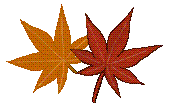
Momiji-gari
(Autumn leaf viewing )
Japanese
Just as the "sakura" or cherry blossom represents Spring, the "momiji" or autumn leaves, have traditionally represented Autumn in Japan. The pleasurable pastime of viewing autumn colors is called "momiji-gari", which literally means "hunting the autumn leaves". Japanese people enjoy momiji-gari, which is regarded as a seasonal event equally as important as "hanami", or flower viewing, and both practices are deeply rooted in their lives.
Originally the practice of viewing autumn colors is thought to have started off as an elegant pastime mainly enjoyed by the court and aristocracy in the 7th century. That changed, however, around the 17th century during the Edo period, when the custom spread to commoners and people began to hold "sake" parties and sumptuous feasts while viewing the beautiful autumn landscapes.
In general the use of the term momiji is applied to all deciduous trees that produce autumnal leaves toned with a red or yellow color, including maple, the Japanese lacquer tree, and the ginkgo. The term has also come to be used to represent the maple, the actual name for which is Kaede, because of the particular beauty of the leaves of that tree.
There are many Japanese tanka and haiku poems about the autumn leaves and the joys of viewing them. The momiji tradition has also found expression in the noh and kabuki theatrical forms. Kimono and obi sashes have also incorporated special traditional autumn motifs.
Like the cherry blossom, the momiji reaches its peak in a rather short time and then fades and drops off the tree. It represents delicate short-lived beauty that Japanese people are traditionally fond of, like a samurai, who has lived a short but honorable life. Autumn leaves peak and then fall, following by the first snows of winter, completing the natural life cycle that Japanese have experienced for centuries.
